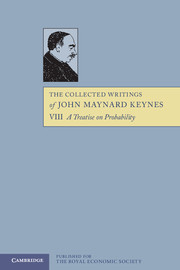Book contents
- Frontmatter
- Contents
- General Introduction
- Editorial Foreword by R. B. Braithwaite
- Editorial Note
- Preface to the First Edition
- I FUNDAMENTAL IDEAS
- II FUNDAMENTAL THEOREMS
- III INDUCTION AND ANALOGY
- 18 INTRODUCTION
- 19 THE NATURE OF ARGUMENT BY ANALOGY
- 20 THE VALUE OF MULTIPLICATION OF INSTANCES, OR PURE INDUCTION
- 21 THE NATURE OF INDUCTIVE ARGUMENT CONTINUED
- 22 THE JUSTIFICATION OF THESE METHODS
- 23 SOME HISTORICAL NOTES ON INDUCTION NOTES ON PART III
- IV SOME PHILOSOPHICAL APPLICATIONS OF PROBABILITY
- V THE FOUNDATIONS OF STATISTICAL INFERENCE
- Bibliography
- Index
22 - THE JUSTIFICATION OF THESE METHODS
from III - INDUCTION AND ANALOGY
Published online by Cambridge University Press: 05 November 2012
- Frontmatter
- Contents
- General Introduction
- Editorial Foreword by R. B. Braithwaite
- Editorial Note
- Preface to the First Edition
- I FUNDAMENTAL IDEAS
- II FUNDAMENTAL THEOREMS
- III INDUCTION AND ANALOGY
- 18 INTRODUCTION
- 19 THE NATURE OF ARGUMENT BY ANALOGY
- 20 THE VALUE OF MULTIPLICATION OF INSTANCES, OR PURE INDUCTION
- 21 THE NATURE OF INDUCTIVE ARGUMENT CONTINUED
- 22 THE JUSTIFICATION OF THESE METHODS
- 23 SOME HISTORICAL NOTES ON INDUCTION NOTES ON PART III
- IV SOME PHILOSOPHICAL APPLICATIONS OF PROBABILITY
- V THE FOUNDATIONS OF STATISTICAL INFERENCE
- Bibliography
- Index
Summary
1. The general line of thought to be followed in this chapter may be indicated, briefly, at the outset.
A system of facts or propositions, as we ordinarily conceive it, may comprise an indefinite number of members. But the ultimate constituents or indefinables of the system, which all the members of it are about, are less in number than these members themselves. Further, there are certain laws of necessary connection between the members, by which it is meant (I do not stop to consider whether more than this is meant) that the truth or falsity of every member can be inferred from a knowledge of the laws of necessary connection together with a knowledge of the truth or falsity of some (but not all) of the members.
The ultimate constituents together with the laws of necessary connection make up what I shall term the independent variety of the system. The more numerous the ultimate constituents and the necessary laws, the greater is the system's independent variety. It is not necessary for my present purpose, which is merely to bring before the reader's mind the sort of conception which is in mine, that I should attempt a complete definition of what I mean by a system.
Now it is characteristic of a system, as distinguished from a collection of heterogeneous and independent facts or propositions, that the number of its premisses, or, in other words, the amount of independent variety in it, should be less than the number of its members.
- Type
- Chapter
- Information
- The Collected Writings of John Maynard Keynes , pp. 279 - 294Publisher: Royal Economic SocietyPrint publication year: 1978



